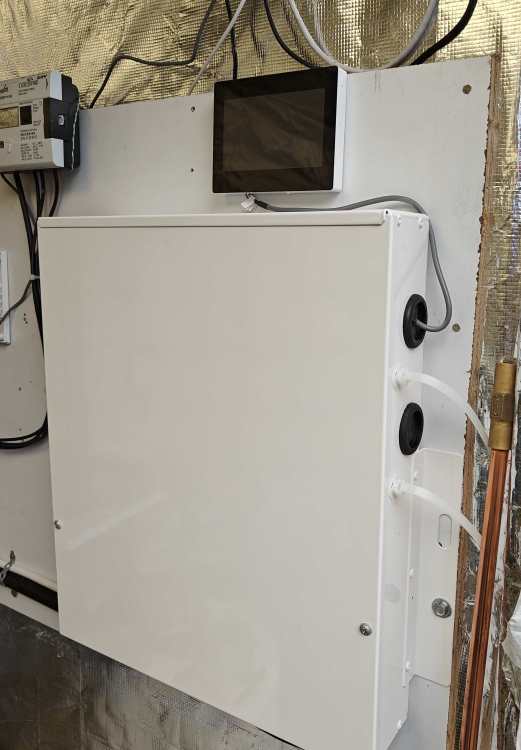-
Posts
11922 -
Joined
-
Last visited
-
Days Won
173
Everything posted by JohnMo
-

I don't have green fingers, what to do?
JohnMo replied to Post and beam's topic in Landscaping, Decking & Patios
I would clear the rubbish that's there already make flat, then leave until spring, then kill every that pokes it head up with an agricultural weed killer. Level as required, leave for 4 weeks and kill everything again. Then try not to disturbed soil to much or more annual weeds will come up. Brambles will keep coming up for so you will need to keep on top of those over time. Then do what you will with it. -
No not used one, but I have a pump with a thermostat and a simple timer. Works fine. We have a manifold in the centre of the house, from UVC, then to each wet room. Secondary circulation is only to the ensuite which is furthest away from the cylinder. But with the secondary return off the shower is flowing hot by the time I have undressed a d ready to get in - 20m pipe run in 15mm.
-
Decided after all to stay simple, DHW by immersion, will have plenty of excess solar in summer that will not be generated due to export limits. So better to use it via immersion than loose it. So wiring is complete. Have retained the smart grid switching to allow flow temp boost if I need it for the summer house, have retained the open source monitor system (energy and performance monitoring). So wiring actually done by me, power cable, SG switching 2 core cable, which then connects to inside house via existing trenched SWA cable (already in place for existing HP), this connects to UFH controller, so I have remote (hardwired) manual temp over-ride for summer house temperature. Once outdoor unit in place it's just power cables and shielded comms cable. A some basic pipe work mods. Image below left to right, isolation switch wiring center and performing), electric meter for heat pump, heat meter for heat pump, Hiaer controller, below that, simple wiring center, then the main control/wiring center for Hiaer heat pump.
-
Proctor Roofshield is supposed to be UV stable
-
That's the avoided answer - it's cycling because it's too big. If I'm reading the numbers correctly the 10kW at 7 degs and 35 flow a min output of 5.8kW. When running cop will be 5.8, but then the impact of cycling will bring this down. The 7kW min output at 7 degs is 3.2kW, so will still cycle but only a couple timescale day, the chart indicates a cop of 4.9. which is pretty rubbish. By way of comparison a Haier R290 35 flow, for a max 6kW demand at -2 and at 3kW at 7 degs A 6kW is suitable putting out 6.4kW at -2, at a CoP of 4.17, at 7 degs CoP is 5.4 and is mid range of it's output, it's min modulation at 15 degs is 1.8kW at a cop of 7.24. So should run none stop from start of heating season to the end for almost any house.
- 39 replies
-
- mvhr
- ashp and dhw
-
(and 2 more)
Tagged with:
-
As @Nickfromwales is aware my real life view of woodcrete ICF is very different from his. We have never had any water come through the walls, no damp issues period, 5 years and counting since the walls went up. Yes we did parge coat to the inner wall for airtightness, 2 days work. We then attached 50mm battens (service void) and then plasterboard. Out of all the systems (Durisol) was easiest for me, no special props required etc. Just simple had tools.
-
Forgot to mention DHW, this was to be by immersion only. Have rethought this, as all the hardware and cables are in place, to switch the 3 port valve. But gone a much simpler layout than previously. Immersion is standalone and not connected to heat pump at all. Any issues with heat pump, just flick immersion on. Routing was always difficult to sensor probe from heat pump to cylinder but that has been solved by repurposing a cable or two not in use, that running through the house. But includes the cable I was going to use for the smart grid switching. One problem solved, one created.
-
Jobs done today The feet I bought to go underground the heat pump were 1m long, so trim them down to a more manageable length of 800mm. Moved the heat pump from patio to closer to the final location. Used a simple garage trolley located under the manufacturers pallet. Next job is to cut off the pallet away at the light end (condenser end) and affix a foot. This will give something to lever against so when in final position the remaining pallet can be removed and the other two feet added. Completed all wiring as far as possible. So 3 core cable for power, 2x0.75 screened cable to outside unit and further 2 core to the smart grid connection (can't complete this as cable from house is currently connected to other heat pump. I heat the summer house as part of the same zone as the house, it runs at 18 to 19.5 normally, but sometimes we need it warmer, so I normally use a thermostat to trigger a second setpoint for the heat pump, which works fine and floor just buffers the heat. The Hiaer unit, I will utilise the smart grid connection, and set a 2 Deg uplift in flow temp when the connections across terminals for SG2 (EVU signal) are closed. The same connection can reduce the cooling flow temp should I need it. Also made some covers out of excess OSB from the house build, to cover some gravel I need to travel over. Looks like next weekend to do the heat pump change over.
-
You can cover this in another thread rather than clogging this one up. Just need to start it.
-

Decentralised mvhr
JohnMo replied to Jane W's topic in Mechanical Ventilation with Heat Recovery (MVHR)
When I did my new build I priced up Fresh-R, but got push back from building control on flow rate not matching building regs. But the concept is good and can be made to work with ordinary MVHR units, using cascade ventilation. So extract from all wet rooms, add air in a central location, so it passes through other areas before being extracted. Between room fans if layout demands it. -
No chlorine, so not really pool type water. Will monitor pH and drop and top as needed to that in check
-
No, but also not using any chemicals either, so no need for titanium heat exchanger. ASHP not connected yet. But when running, modulation down to 1kW should mean it just runs, so should never see the 14W on its own and should be accounted for in the running CoP.
-
It's just being repurposed - the 6kW unit will be used to heat 1700 litres of water (hot tub). Just been outside with dog, while I was waiting about I was feeling all the edges of the metal, everything seems nice and rounded off, nothing sharp at all. 90+kg to move about, that will be fun - not. Set up the controller this afternoon, only thing I can't do is load the WC curve, because the unit doesn't see the flow and return temps as no outdoor unit is connected. Had a look at the electrical draw The whole wiring centre and controller pulls a continuous 14W.
-
MVHR dies summer bypass automatically cannot change it, not sure how it helps, unless it increases heat demand, which not sure below the back pocket
-
Nope not enough cooling effect. UFH in cooling mode leads to a nice house
-
It's minimum modulation is near 4kW, house demand is only 3.5kW max. Normal run of things I wouldn't change it, but we have just bought a wooden hot tub, so will repurpose the old unit to heating the hot tub, instead of the normal wood fired heater. So get a heat pump more appropriate to the house demand. Should make a decent dent in running costs, with better CoP in summer and winter, for very little money.
-
-
There is the inverter controller outside but I think the indoor wiring centre controls most things The relay is for cylinder immersion control. You can drive a couple of secondary pumps, mixer valve, 3 port valve etc. plus lots more.
-
Yes and Wolesely don't tell you any different. They want a restocking fee to take it back. They do sound small, I keeping my 50L volumiser in system so will retain the existing expansion vessel in circuit.
-
Just need some warmer weather to allow old heat pump to be removed and this one installed. Have had to add antifreeze valves, part of the warranty conditions. Have got Inta Zero ones that reference water temperature not air temperature. Brand new half price bargain from eBay.
-
Some photos Indoor wiring centre with controller installed (no wiring installed). Simple install screened cable to outside unit and power. Cover on and wing complete, all metal casing and very heavy duty. No sharp edges. Outdoor unit, for a 4kW unit it's pretty big, the condenser and fan are very big compared to the Maxa unit currently installed which is a 6kW.
-
So took delivery of the 4kW Haier ASHP today. So far first impressions are very good. Consists of an outdoor unit, complete with expansion vessel and pressure relief valve, inside the monobloc. Inside the packaging is also a controller and indoor wiring unit. So can return the one I thought I had to buy. So total cost is £2100 delivered to the door from Wolesely. Photos to follow with full install story









